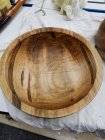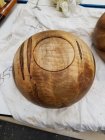Hi all,
I know that maple is very prone to splotching, but I'm wondering if that's really what this is. I finally finish-turned a rough ambrosia maple bowl I had on the shelf for a while. The dark spots appeared as soon as I applied finish (danish oil (TNT)). I also can't help but notice that they are also primarily around the end grain.
Did I do something "wrong", or is this just the chance you take with some woods? Wondering if there's something I could have done differently to prevent this. Everything was sanded to 600 grit before I had added the finish. Mold? Nothing I could see beforehand, but not impossible. If this were flatwork, I would have sanded the endgrain a little higher to compensate, but that's a little harder to do here.
Thanks as always for any input!
Dan


I know that maple is very prone to splotching, but I'm wondering if that's really what this is. I finally finish-turned a rough ambrosia maple bowl I had on the shelf for a while. The dark spots appeared as soon as I applied finish (danish oil (TNT)). I also can't help but notice that they are also primarily around the end grain.
Did I do something "wrong", or is this just the chance you take with some woods? Wondering if there's something I could have done differently to prevent this. Everything was sanded to 600 grit before I had added the finish. Mold? Nothing I could see beforehand, but not impossible. If this were flatwork, I would have sanded the endgrain a little higher to compensate, but that's a little harder to do here.
Thanks as always for any input!
Dan


